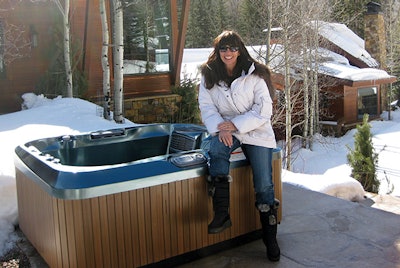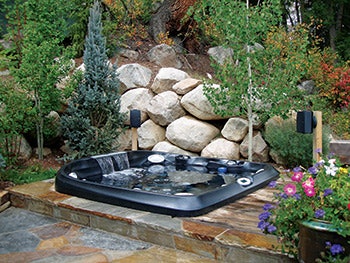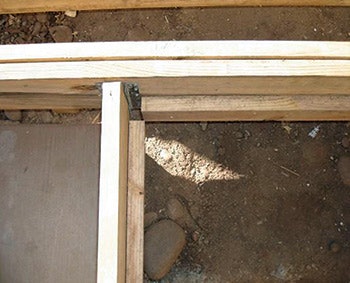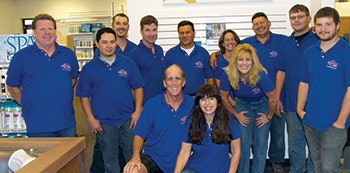

As retailers, we offer our customers the hot tub lifestyle, and the purchase of the hot tub itself is just the beginning. The spa’s location on the property, the hot tub’s surroundings and the job of installing it correctly (and legally) are all important steps in giving customers what they really want — a great, trouble-free experience with their new spa.
Many of these installation details are worked out when the professional retailer/designer visits the site to examine the possibilities firsthand.
As the retail expert guiding the sale and installation, your customers count on you to steer them away from potential pitfalls of spa ownership. When they come into a showroom, they’re not thinking about the pitch of their roof and whether snow could pile up there, slide down and drown them. That’s the stuff you should be looking at.
And you need to flag the problems before the work begins. After you’ve started installation is the wrong time to realize the spot you selected does not have proper clearances or you can’t run conduit to the right place. Little things like “How far is the nearest plug?” and “How will we light this place?” — your clients probably haven’t thought about things like that, so you have to.
There’s quite a bit to cover once you get into somebody’s backyard and start talking about installing a hot tub. There’s limited time to cover all aspects of the project, from warranty considerations to operational tips, so let’s get started.
Warranty Considerations
More and more, my customers are interested in self-contained spas that are built-in and nicely integrated into the surroundings, not just set down on a poured concrete slab.
But either way, you have to install it a certain way for the warranty to remain in effect. For instance, the brand I sell requires you have a homogeneous foundation. You can’t just have four corners and a bunch of gravel down there. You have to meet these and other specifications if you want to keep that seven- to 10-year warranty.
Another thing is the fold in the cover. The fold can’t be on the controller. If it is, you’ve just voided the warranty on the spa-side control. Some people only find out when it’s too late.
Code Issues
The electric codes you use when you install a hot tub come from the universal code — that’s the big book construction guys carry around — but you also have to follow the state, county and municipal codes. Even the part of town you’re in may have certain codes.
As an example, here in Aspen, Colorado, there’s a small neighborhood interested in historical preservation, and they have their own code. I had a customer from that neighborhood who wanted to put a hot tub up on his roof deck. No problem, right? Wrong. The historical society made him close off part of his deck and make it unusable to make sure he didn’t have parties up there. They felt it would disturb the character of the neighborhood.
Some people try to ignore or get around codes, especially ones like the above, but you’re better off just following them. More often than not, if and when they catch you, you’ll wish you’d just followed the code in the first place.
Other code subjects might not ring a bell, but they’re just as important. Take railings, for instance. A lot of railings on high-end homes these days are metal, and all metal railings have to be grounded. So you need discuss that with your electrical contractor before the installation so he doesn’t have to try to ground it after the fact.
Plugs that are within 10 feet of the spa must be disconnected and closed off. You can’t have a live plug close to the spa. And a power outlet that you use to power the spa has to be hard-wired with a GFCI and may need its own circuit breaker at the panel.
Also, if the spa load is too much for the other plugs on the same branch, those plugs will have to be separated out at the panel by your electrician.
When we’re looking over the site, the customer might be thinking, “Oh, this would be a nice setting for the hot tub,” but we’re actually looking for things like electrical code issues that the customer is usually unaware of.
Energy Programs And Regulations
State and local government have their own regulations that may come into play. In my area, we have a countywide energy regulation called the Renewable Energy Mitigation Program.
You cannot put in a portable spa unless it meets REMP requirements for energy efficiency. There are a couple of spa brands that do not, and you can’t sell them here.
Sometimes a spa company will try to go around it, and when they get caught, the county shuts them down. Installations are halted, and the company will get a fine.
This same REMP regulation says that if you want to build a custom gunite spa, you have to pay up to a $5,000 fee to the county just for the privilege. (They have hefty fees for installing a swimming pool as well.)
There are often regulations on the use of cranes, including when and were a crane can be parked. Some areas require permits, and there may be rules about when they can and cannot be granted. Since we use a crane in about 60 percent of our hot tub deliveries, we pay close attention to these rules.
In addition, you have to personally manage the traffic you are affecting. In one instance, we needed to put a crane on a major bus line — and since the bus came through every 10 minutes, we knew this could be an issue. Before the big day, I went down to the bus barn, spoke to the transit people and got their cooperation. The company ended up re-routing the bus to take a side street while we were working, and they really appreciated us working it all out ahead of time.
Basically, it’s your responsibility to manage the problems you are creating with your installation.
Over time, your reputation with the city comes into play. They learn whether you are the kind of company that is trying to play by their rules — and there are a lot of rules — or whether you’re trying to get away with something. They’re a lot easier to work when they know you’re cooperative.
Homeowners Associations
Generally, associations don’t want to see your hot tub. I had a customer last year who wanted a hot tub on her deck, and the homeowners association insisted I get written permission from every one of her neighbors. Which I did. And we had to plant a tree to screen the installation.
So when somebody comes to you and says, “I just bought a condo and I want to put a hot tub on the deck,” keep in mind that some condo associations don’t even allow hot tubs on decks, and others only do under certain circumstances. I’ve lost a sale more than once because of a homeowners’ association that wouldn’t permit the installation.
However, you can sometimes modify the installation to meet the association rules. For example, some don’t want a hot tub to reach above a certain height. I had an elderly couple that wanted a hot tub, but in order to get in the water they needed to sit on the side of the tub and swing their legs in. But the homeowners association wouldn’t let them install their hot tub at chair height; it could only rise a few inches above the deck.
So we built them a drop box so they could step down below deck level, and then sit on the edge of the hot tub, and pivot into the water. That time, we got around the rule and were able to make the sale.
Lifter Clearances and Delivery Path
Cover lifters have brackets that require a certain amount of clearance to open. When you’re on the site visit, bring along a cheat sheet that details the clearances you need to install the cover lifters you sell. That way, when you’re sizing a space for a hot tub, you can also size the space for the cover lifter, too.
You also need to be able to deliver the spa to the site. I’ve gone to homes that have a nice path to the backyard, and it looks like we can just roll the tub in there, but the path runs under a roof overhang so low that a 7-foot hot tub won’t fit under on its side. We end up craning those in, but of course, I’d much rather wheel it in than crane it in.
Above all, I don’t want to hurt my guys on a hot tub install, and you can get hurt delivering a 500-pound spa. I want to send every one of my guys home to their wives with their back intact.
I had somebody who wanted to put a spa in a room he was building, but then he went ahead and built the walls before we could get it there! So we had to crane it in through the window. We slid it in there like a fat piece of toast going into the toaster. We had to build scaffolding inside the room to lay it on once we pulled it through the window — and we did it without scratching the floor! That customer just left a referral on my site, and it almost made me cry.
Hatch and Header
I talk a lot about access to the hot tub equipment. We’re supposed to have three feet of access room to any electrical panel, and that’s per the code. So when people throw a hot tub in a hole, and there’s no access to the equipment panel, that’s a violation.
If I put a hot tub in a deck, I have to build a hatch that I can remove, as well as a header — which is supporting the hatch — that can also be removed so I can open up the panel and get in to the equipment.


I like wood hatches best. Stone in winter gets wet and tends to freeze, whereas water drains out of wood, so it doesn’t pool up and freeze. On the hatch I cut a little hand notch, just big enough to stick four fingers through and pull out. I used to use a metal ring but if the wood rots a little bit, those can rip out.
I’m finding that companies are burying things deeper and deeper in the equipment pack, and that means that you really need to think about the spa you’re installing — how deep am I going to have to go into that equipment to get to everything? — and make sure your access plan allows that.
Also, you have to remember this hot tub is only going to last 10 or 12 years. Someday, they’re going to replace it with a new one. So when you design your vault or hole, keep that in mind. The next hot tub they put in here needs to fit as well, so give yourself a little slack in the vault and bring the finish work right up to the spa.
Elements of Design
Elements of design are the things I look at around the house — the type of stone, the type of wood, the type of design finishes. Let’s say they use a weathered post with big bolts, or a carving, I try to bring those elements into the hot tub installation, because I want it to end up looking like everything — the spa and its surroundings — was born at the same time.
Hot Tub Access
When people talk about entry and access to the hot tub, the first question I ask is, “When you’re going to the hot tub, where are you coming from?” Make that path as simple and short as possible.
Here in snow country, I have a coefficient of procrastination that says for every foot of walkway to your spa that you have to shovel in winter, it’s another minute of procrastination. So if the spa is 10 feet away from your door, that’s 10 minutes of procrastination before you actually go out there and do it. So maybe you don’t do it at all.
I had a woman who wanted to put her hot tub on a cute little trail way up on a hill away from the home. I said, “You will never use that hot tub. Maybe once, twice or ten times, but you’ll never use that hot tub regularly.” And she said, “You know, I never thought about it that way.”
And that’s what the site visit is about, helping customers think these things out. So the entry to the hot tub, where it’s located, what door the customer will come out of, the lounge chair view (a lot of people think that’s important), these things need to be settled at that time.
You can’t be afraid to tell a customer why you think what they’re suggesting might be a bad idea.
Snow and Ice
This is only a problem for some people, but when snow falls off the roof you don’t want it to fall on the hot tub. I’ve had hot tubs completely destroyed that way. And icicles forming on the edge of the roof can be a problem, too; they can fall and turn a $580 cover into garbage in no time at all. And you definitely don’t want water draining down onto the hot tub.
You don’t necessarily have keep the hot tub clear from the roofline as long as the roof isn’t too steep and the homeowners have a gutter. You want to avoid water dripping on your customers or the spa cover, but you can usually tell by looking at the roofline.
Drainage
Drain location is important, too. If you put your drain under your hot tub, you’re often simply blocking the drain with the edge of the hot tub. There’s no way any water is going to get to that drain.
And when you’re putting a hot tub in a vault or hole, we want to stub out the conduit through the wall, not the bottom or floor. This will make sure that the conduit doesn’t fill with water, freeze and then start causing problems.
The Upsell
When I get out to someone’s home, naturally, I’m looking at their entire outdoor situation. Heck, I’m in their backyard, I’ve got the invitation, they’re listening to my suggestions already, so I’m saying things like, “I could really see a nice firepit and patio set right here. You know, if you improved the concrete a little bit, you could put a seating area right here.”

The upsell is where we really make money. That’s the frosting on the cake. It’s just silly not to upsell people once you’re in their backyard.
So I have my firepit and outdoor accessory brochures with me when I go back there, and I’m looking for an opportunity to talk about possibilities.
And you know, sometimes they say, “We want to do all of that.”
And sometimes they say, “We want to do none of that.”
And sometimes they come back a year or two later and say, “Remember what you were talking about with the firepit and water wall? We’d like to do that now.”
The upsell is really dependent on your ability to create excitement in the customer, and that depends on your own feelings about the product. You’ve got to be excited about it yourself.
When people are buying a spa, they’re already excited. It’s probably the most exciting product in their house. You need to capitalize on that.
Comments or thoughts on this article? Please e-mail [email protected].











































